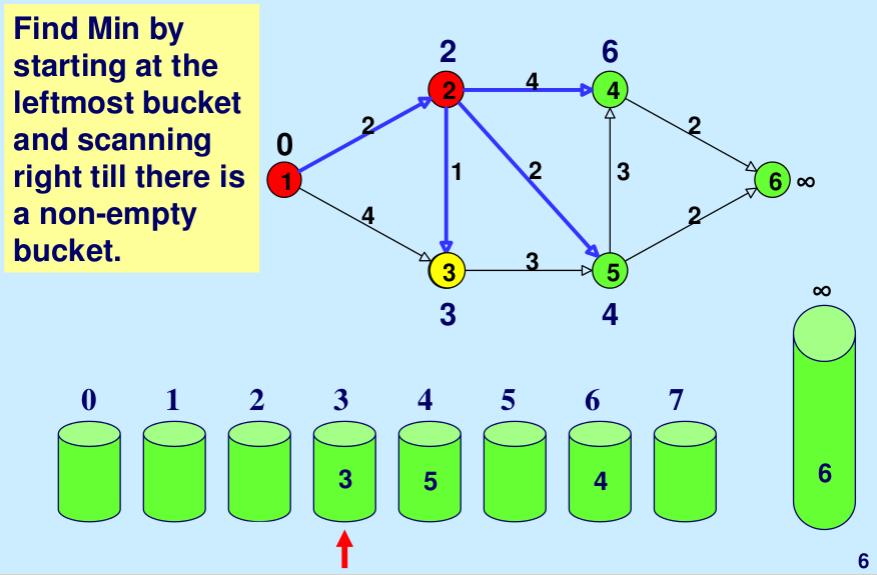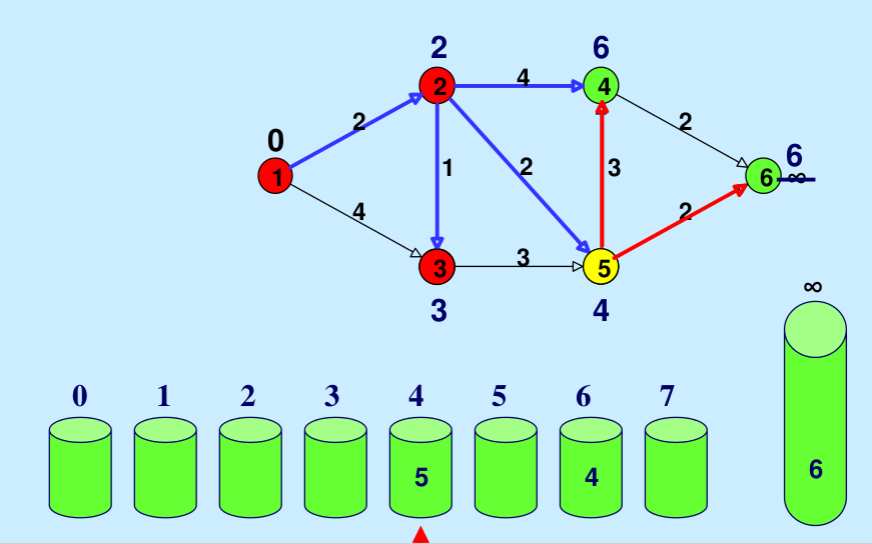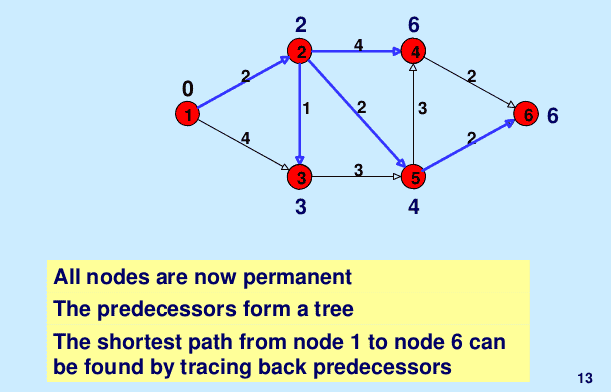Dijkstra的最短路径算法用邻接列表表示法实现时,运行时间为O(Elog V)(参见 C.执行 和 基于STL的C++实现 详细信息)。
null
Input : Source = 0, Maximum Weight W = 14 Output : Vertex Distance from Source 0 0 1 4 2 12 3 19 4 21 5 11 6 9 7 8 8 14
如果最大权重很小(或边权重的范围很小),我们能否优化Dijkstra的最短路径算法,使其比O(E log V)更好地工作? 例如,在上图中,最大重量为14。很多时候,中边上的权重范围都很小(即,所有边权重都可以映射到0、1、2..w,其中w是一个小数字)。在这种情况下,Dijkstra的算法可以通过使用不同的数据结构bucket进行修改,这就是Dijkstra算法的拨号实现。时间复杂性是 O(E+WV) 其中W是图的任何边上的最大权重,所以我们可以看到,如果W很小,那么这个实现比传统算法运行得快得多。以下是重要的观察结果。
- 任意两个节点之间的最大距离可以是max w(V–1)(w是最大边权重,两个顶点之间的边可以是max V-1)。
- 在Dijkstra算法中,距离以非递减的方式确定,也就是说,距离较近(到给定源)的顶点的距离在距离较远的顶点之前确定。
- 维护一些桶,编号为0,1,2,…,wV。
- Bucket k包含距离等于k的所有临时标记的节点。
- 每个桶中的节点由顶点列表表示。
- 桶0,1,2,。。连续检查wV,直到找到第一个非空桶。根据定义,第一个非空桶中包含的每个节点都有最小距离标签。
- 在扫描过程中,这些带有最小距离标签的节点会一个接一个地被永久标记,并从存储桶中删除。
- 因此,涉及顶点的操作包括:
- 检查桶是否空
- 向桶中添加顶点
- 从桶中删除顶点。
- 当顶点的距离标签更改时,临时标记的顶点在桶中的位置将相应更新。
- 重复该过程,直到所有顶点都被永久标记(或所有顶点的距离最终确定)。
由于最大距离可以是w(V–1),因此我们创建了wV bucket(更多是为了简化代码),用于实现算法,如果w很大,那么wV bucket可能会很大。
// C++ Program for Dijkstra's dial implementation #include<bits/stdc++.h> using namespace std; # define INF 0x3f3f3f3f // This class represents a directed graph using // adjacency list representation class Graph { int V; // No. of vertices // In a weighted graph, we need to store vertex // and weight pair for every edge list< pair< int , int > > *adj; public : Graph( int V); // Constructor // function to add an edge to graph void addEdge( int u, int v, int w); // prints shortest path from s void shortestPath( int s, int W); }; // Allocates memory for adjacency list Graph::Graph( int V) { this ->V = V; adj = new list< pair< int , int > >[V]; } // adds edge between u and v of weight w void Graph::addEdge( int u, int v, int w) { adj[u].push_back(make_pair(v, w)); adj[v].push_back(make_pair(u, w)); } // Prints shortest paths from src to all other vertices. // W is the maximum weight of an edge void Graph::shortestPath( int src, int W) { /* With each distance, iterator to that vertex in its bucket is stored so that vertex can be deleted in O(1) at time of updation. So dist[i].first = distance of ith vertex from src vertex dits[i].second = iterator to vertex i in bucket number */ vector<pair< int , list< int >::iterator> > dist(V); // Initialize all distances as infinite (INF) for ( int i = 0; i < V; i++) dist[i].first = INF; // Create buckets B[]. // B[i] keep vertex of distance label i list< int > B[W * V + 1]; B[0].push_back(src); dist[src].first = 0; // int idx = 0; while (1) { // Go sequentially through buckets till one non-empty // bucket is found while (B[idx].size() == 0 && idx < W*V) idx++; // If all buckets are empty, we are done. if (idx == W * V) break ; // Take top vertex from bucket and pop it int u = B[idx].front(); B[idx].pop_front(); // Process all adjacents of extracted vertex 'u' and // update their distanced if required. for ( auto i = adj[u].begin(); i != adj[u].end(); ++i) { int v = (*i).first; int weight = (*i).second; int du = dist[u].first; int dv = dist[v].first; // If there is shorted path to v through u. if (dv > du + weight) { // If dv is not INF then it must be in B[dv] // bucket, so erase its entry using iterator // in O(1) if (dv != INF) B[dv].erase(dist[v].second); // updating the distance dist[v].first = du + weight; dv = dist[v].first; // pushing vertex v into updated distance's bucket B[dv].push_front(v); // storing updated iterator in dist[v].second dist[v].second = B[dv].begin(); } } } // Print shortest distances stored in dist[] printf ( "Vertex Distance from Source" ); for ( int i = 0; i < V; ++i) printf ( "%d %d" , i, dist[i].first); } // Driver program to test methods of graph class int main() { // create the graph given in above fugure int V = 9; Graph g(V); // making above shown graph g.addEdge(0, 1, 4); g.addEdge(0, 7, 8); g.addEdge(1, 2, 8); g.addEdge(1, 7, 11); g.addEdge(2, 3, 7); g.addEdge(2, 8, 2); g.addEdge(2, 5, 4); g.addEdge(3, 4, 9); g.addEdge(3, 5, 14); g.addEdge(4, 5, 10); g.addEdge(5, 6, 2); g.addEdge(6, 7, 1); g.addEdge(6, 8, 6); g.addEdge(7, 8, 7); // maximum weighted edge - 14 g.shortestPath(0, 14); return 0; } |
输出:
Vertex Distance from Source 0 0 1 4 2 12 3 19 4 21 5 11 6 9 7 8 8 14
本文由Utkarsh Trivedi撰稿。如果您发现任何不正确的地方,或者您想分享有关上述主题的更多信息,请写下评论。
© 版权声明
文章版权归作者所有,未经允许请勿转载。
THE END














![关于”PostgreSQL错误:关系[表]不存在“问题的原因和解决方案-yiteyi-C++库](https://www.yiteyi.com/wp-content/themes/zibll/img/thumbnail.svg)



